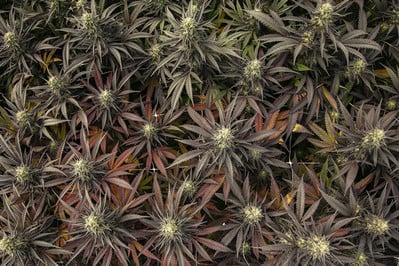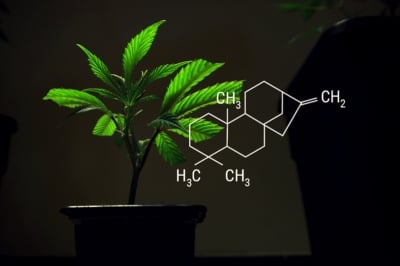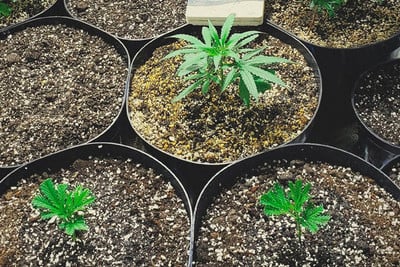.

Basic Cannabis Knowledge: Genotype and Phenotype
Many growers tend to misuse the words genotype and phenotype when talking about cannabis. Let’s clear the smoke around this issue and resolve all the unnecessary confusion.
Contents:
There’s a point in the life of every grower when suddenly questions arise. Most of the time, this moment of confusion comes right after completing the first couple of grows, and at the latest, when the same strain is repeatedly grown using the identical set-up.
Why in the world does every single cannabis plant grown from seed look slightly different?
When these or similar questions remain unanswered, a logical reaction for a rookie grower would be to switch to another breeder. The more experienced cultivators know that this phenomenon, meaning variations among different plants of the same strain, is inherent and won’t get any better by changing the seed supplier. We have to keep in mind that seeds are products of living organisms and the outcome of a crossbreeding process; thus they are as unique as any person, animal, or plant on Earth. Although it’s tempting to characterise everything around us, we’re quick to reach limitations when dealing with nature.
Genotype, Environment, Phenotype
Every living organism is the result of evolution that works by the same basic principle. The genotype or genetic code carries all the genetic information regarding growth, appearance, and all the characteristics we can later observe.Genotype is determined by the genes a plant inherits from its parents. It’s crucial to understand that a the genotype defines a specific range of possibilities. The expression of the genotype also depends on the environment the organism lives in and what specific bits and pieces of the genotype will be expressed. The interaction between genotype and environment results in a phenotype, meaning the physical expression of specific genes activated by the environment.
| phenotype (P) | genotype (G) + environment (E) + genotype and environment interactions (GE) |
| phenotype (P) |
genotype (G) + environment (E) + genotype and environment interactions (GE) |
-
Quick Example: Purple Strains
Let’s examine a cannabis related example to get a better idea. You purchase seeds from a reputable breeder and intend to grow a purple strain. Instead of growing all plants in your indoor grow tent, you’ll decide on moving half of your plants outdoors. Besides the fact that no plant seems to be identical to one another, you’ll notice that the plants in your outdoor garden are much richer in purple colors compared to the ones in your indoor grow tent. Although the genotype carries the information to produce purple hues, it’s the environment, and in this particular case, the temperatures of the environment, that allow two different physical expressions (phenotypes) from seemingly the same genetic code (genotype).


-
The Common Misassumption
We got the idea that the environment is the determining factor influencing a genotype to express different phenotypes, but this doesn’t answer the initial question why every cannabis plant grown from seed appears to be slightly different, even when it’s grown in a constant environment of an indoor grow room.
How can a strain possibly express different phenotypes when the environment doesn’t change?
Well, it’s maybe an inconvenient truth, but every single cannabis seed has its unique genotype. Many growers assume that seeds from the same cannabis strain share an identical genetic code and understandingly expect homogeneous growth. Unfortunately, this is a common misassumption. There are lots of people using the term phenotype to describe the variations of plants they get from the same strain grown from seed. In fact, and what they usually don’t know, they’re talking about different genotypes. It’s not only the environment that determines phenotypic expression, but logically also the genotype itself.
When you purchase seeds of a certain strain, you’ll receive “family members” of this strain that share a large percentage of genes with thousands of (inbred) siblings, but they’re not identical twins. The genotype is usually very close between plants from the same strain, but there are still differences, comparable to siblings in a family if you will. That’s the main reason why every cannabis plant grown from seed expresses slight variations regarding characteristics like plant height, yield, flavor, etc.—the genotype of seeds is usually not identical.
Pheno Hunting
Cannabis cultivators and breeders pay close attention to phenotype when deciding which strains to grow and cross. The practice of "pheno hunting" allows one to quickly sift through a large quantity of genetics to identify traits that suit their desires and growing situation.
The method involves sowing a variety of different strains (or many seeds belonging to the same strain), growing them out, cloning them, and hunting for key characteristics.
Pheno hunting enables you to test and trial a bunch of genetics at one time. However, some growers choose to pheno hunt by starting out with seeds from the exact same mother plant. This process allows them to scout out the best phenos within a narrow range of variability to hone in on the finest traits a particular strain has to offer.
Once a grower finds a desirable pheno, they can “lock in” these desirable traits by continually cloning the specimen. While adding more genetics to the equation creates more variability once again, breeders can draw out and stabilise—the traits they like through techniques such as inbreeding or backcrossing.
%20(1).jpg)
%20(1).jpg)
Pheno hunting doesn't include the creation of new traits, or the development of extreme attributes; the features you are looking for should already exist within the strain's genetics.
How to Pheno Hunt: Step by Step
Pheno hunting allows you to personalise the cannabis growing experience. Before you start the process, you need a good amount of space, enough pots to house several waves of clones, nutrients and light to keep them all healthy, and an area in which to dry and cure your harvests. Once you have these in place, it’s time to start hunting down your dream phenos.
So you have an idea of the timeframe, it can take a commercial grower several plant generations until they get the desired pheno.
Roughly speaking, pheno hunting can take at least 6 months. This includes germination, growing, cloning, phenotyping and selection of the best specimens.
Step 1: Sow Seeds
First things first; you need to select and sow the strains you want to grow. However, ensure that you tag your cultivars so you’re aware of exactly what’s growing, where. If growing lots of different strains, just tag them with their appropriate name or initials. If growing multiple plants of the same strain, let’s say Royal Gorilla, for example, then tag them RG1a, RG2a, RG3a, and so on. Going forward, you’ll simply swap out “a” for “b” to indicate which plant your clone derives from. If you decide to clone your clones, you’ll switch to the letter “c” in the tags to keep track. You can use wooden lollipop sticks as tags in or around the corresponding pots, or switch to plant tags when your specimens are big enough.


Step 2: Clone Your Original Crop
After germination, you’ll raise your plants as usual. Within 4–6 weeks, they'll have packed on some size and developed plenty of healthy “true” leaves; these signs mean it's time to clone. You can make biological copies of each plant using several methods/substrates, including soil, Rockwool, and water. Don’t forget to tag your cutting as soon as you take them from the mother plant to avoid any confusion further down the line.
But why bother taking cuttings from your recently seeded crop? Because doing so will give you direct biological copies of each individual plant. As long as they remain in relatively similar conditions, they’ll display the exact same traits as the mother plants from which they came. While your mother plants continue to grow, you can experiment with the clones to see how they adapt to experimental procedures such as pest exposure, training, and temperature shifts.
Step 3: Grow Out the Clones Separately
At this point, you’ll have doubled your plant numbers. If you started out with 10 plants, you’ll now have 20 at your disposal. Next, you’ll want to create a separate growing area in which your clones can thrive.
Indoors, this will allow you to switch your original plants to a flowering light cycle while keeping your clones in a vegetative state. Your mother plants will start to develop flowers that you can sample to see which phenos you like best in terms of taste and effect. When they start to bud, you can put your clones through their paces to see how they react to the future stressors you're likely to subject them to.
Step 4: Switch Original Crop to Flowering
Change the light cycle to 12 hours on and 12 hours off to force your mother plants into flowering mode. Depending on the strains you’ve chosen, it will take anywhere from 8–12 weeks for them to fully mature. Different strains will also reach maturity quicker than others, so look out carefully for signs of when to harvest.
Free RQS
Grow Guide!

Step 5: Remove Males
After switching to a flowering light cycle, keep your eyes peeled for signs of males. Whereas female plants produce resinous buds packed with terpenes and cannabinoids, male plants produce pollen sacs. When these balls open, they release pollen grains that fertilise female flowers on contact.
However, you can catch male plants early by keeping an eye on the preflowers. These small structures begin to form at the nodes (the points where branches meet the main stem) just before flowering begins in earnest.
If you identify a male, remove it from the growing space as soon as possible. Unfortunately, you’ll also have to get rid of the corresponding pheno clone.


Step 6: Look for Desirable Traits
The hunt is on! You’ve removed all of the males (if you encountered any) and have a tent of budding mother plants, and another space filled with vegging clones. It’s time to do the real work.
Before harvest, you need to carefully monitor your mother plant phenos during the flowering stage to look out for desirable characteristics, including:
%20(1).jpg)
%20(1).jpg)
While you patiently wait to taste your phenos for the first time, you can get to work on the vegging clones. Now is the time to watch them carefully, and look for the traits you want your future crops to possess.
Consider the following characteristics of your vegging clones:
- Morphology: You want to keep an eye on the distance between internodes, as this means more potential bud sites and better growth symmetry.
- Training: Do they bounce back from low-stress training and high-stress training well?
- Growing speed: Do you have time to let them grow and veg slowly? Or do you want a pheno that puts on size quickly?
- Cold and heat resistance: Have you set your temps low to find a cold-tolerant pheno? Some plants will fare better than others.
- Pest resistance: If you’re pheno hunting outdoors, how are your clones performing against insect threats?
- Food and water demands: Do some plants need more water or nutrients than others? How do they compare to less resource-hungry examples?
- Root vigour after transplanting: Once you've transplanted a plant, did it grow back quickly? Or did it take more time to recover, if at all?


There’s one final test left: you need to sample the goods from your mother plants! Look for the qualities you love in a cannabis flower, such as:
- Yield: How much of those delicious buds did you harvest? Was it a light harvest, or were you rewarded with a bumper haul?
- Terpene profile: Do you prefer notes of lemon, fruit, sugar, diesel, earth, pine…?
- Effects: Do you want flowers that make you feel relaxed and stoned? Inspired and motivated? Creative? Philosophical?
- Smoothness: Does the smoke irritate your throat or feel silky smooth?
- Smell: Do the flowers smell pungent and pleasing when you take them out of the jar? Or simply underwhelming?
We recommend using the RQS Grow Planner to jot down your thoughts while sampling your buds, and to record any important notes during the entire pheno hunting process.
Step 7: Discard Undesirable Phenos
The purge begins. After picking out your favorite phenos, you need to eliminate the mother plants and corresponding clones that didn't live up to your expectations. Of course, destroying cannabis plants sucks, so we recommend giving them to a friend to help clear out some space.
Step 8: Repeat the Process
Congratulations, you’re now a pheno hunter! You’ve narrowed down your search to your favorite phenos. From here, you have a few options. First of all, you need to create new clones from your first wave of clones. These cuttings will once again bear the exact same traits as the previous clones. Tag them correctly and get them into a veg tent.
Next, you can either flip your first wave of clones to flower or remove them to make more space for fresh clones to experiment with. You can dedicate a few more growing cycles to exposing your weed phenotypes of choice to different environments, lighting conditions, pest pressures, and training techniques.
Once you find exactly what you’re looking for, you can continuously clone your prized pheno to keep a consistent supply of the weed you love the most. You can also raise some of them and cross them with other strains to make new varieties strains and subsequent weed phenotypes that match your preferences perfectly.
End The Phenotype Dilemma: Seeds vs Clones
If you want to take homogeneity to the next level, you have two different options. The first option is to germinate more seeds as you intend to grow, and simply select the ones that express the desired traits at an early stage. But if you’re aiming for maximum efficiency and consistency, your best option is to select a mother plant to take clones from. These clones copy the genotype of the mother plant 1:1 and you’ll continuously end up with the same phenotype assuming a constant environment. Let’s say you grow one of these identical clones using a hydro set-up, and one in organic soil. This varying environment might result in different phenotypes of the same genotype.
Lastly, a recent alternative for achieving homogeneity involves the utilisation of F1 hybrid seeds, where all plants will exhibit the same genotype, resulting in identical phenotypes when cultivated in the same environment.







































